#they are going to be the most iconic trio to ever grace my screen I know it
Text
Pbmychoices Edit Masterpost, Part 1
So I’m not sure that anyone would read or even want this, but I figured why not? It’s been almost 2 years since I started making them and I sometimes can’t even find some of my own stuff! So here’s a nice, organized list! 💕
Bloodbound
MC & LIs
Blood Paint Splatter
XMas Icons 2018
Winter Icons 2018
Valentine’s Day Icons 2019
Endless Summer (this is a big one!)
MCs & LIs: Jake NYE | Quinn NYE | Sean NYE | Estela NYE | Group
Waiting for Book 3
LI Headers: Ver. 1 | Ver. 2 | Ver. 3 | Ver. 4
Merry XMas 2018 • Dressed Up
Happy New Year 2018
My Vaanti Wedding: MC | Jake | Both
Jumanji Edits: MC | Jake | Both
Go Eagles!
Happy Valentine’s Day 2018
Happy Birthday Jake 2018
Wedding with Jake
Characters & Items: MC | Jake | Diego | Sean | Grace | Estela | Quinn | Aleister | Zahra | Raj | Craig | Michelle | Dark Ver. 1 | Dark Ver. 2
Group Shots: Ver. 1 | Ver. 2 | Ver. 3 | Polaroid Pic
Star Gazing
Off the Island Day & Night
Movie Poster
Impatiently waiting to marry Jake
Hogwarts Houses: MC | Jake | Grace
Jumanji Stats: Part 1 | Part 2
MC as Jake McKenzie
The Ending I’m Dreading...
Corinne & Jake: Wedding & Honeymoon
Quinn Appreciation Week 2018
Cute Couples
Missing ES
MC & LIs in Wedding Attire
ES Appreciation Week 2018 Pt. 1 & Pt. 2
Happy 28th Birthday Jake 2019
Paint Splatter LIs
It Lives Beneath
And so it begins...
MC in different outfits & hair
Not be dramatic or anything...
Characters & their Colors
Character Icons & Full Screen
Movie Poster
ILB in A Courtesan of Rome Outfits
I Love Parker Shaw
Imogen is a Disney Princess
Parker Shaw in Harley’s outfit
He makes beige look good
Finley x Parker in the Woods
Happy Holidays
Snow
XMas Icons 2018
Happy New Year 2019
Nerve High & Nerve Low
Winter Icons 2019
Valentine’s Day Icon 2019 | Ver. 2
Wedding Bells
Paint Splatter
Finale Icons
It Lives Poster
Nerve Strong
Character Headers
Never Be the Same
For Mar & her fic “Baby, let’s go to...”
It Lives in the Woods
Aura & Conner
Thanks Cora
Movie Poster
#LoveHacks (this was the first book I ever started to do edits for) (8)
Hollis & Ben: Award Dinner
Perfect Match
Damien or Hayden?
XMas Icons 2018
Rules of Engagement
Wedding Day
I Love You
The Royal Romance
XMas Icons 2018
Impatiently waiting to marry Liam
Veil of Secrets
MC & Flynn: Sunset on the Beach
Multiple Book Characters
My Green Jacket Group (& update)
Top 10 LIs (6/5/18)
My Trio of Dorks
Top 6 LIs (up to TE)
Most Beautiful Non-LI Female Characters (before TE)
XMas Current(ish) LIs & Outfits 2018
Top 4 LIs
Header that’s “not just ES anymore”
THAT Dress
#pbmychoices master list#this took me wayyy too long to complete#endless summer#bloodbound#it lives beneath#it lives in the wood#lovehacks#perfect match#rules of engagement#the royal romance#Veil of Secrets#my edit
27 notes
·
View notes
Text
Firstly, hello! It’s been a long time, almost six months in fact! However, I’ve finally found the inspiration to start writing again. Sometimes it can be hard to feel inspired when you’ve been blogging fairly regularly for over three years, however, I never intended to stop forever, I simply wanted to look forward to writing posts again and well, today is that day!
As a huge lover of makeup, I look forward to seeing what products are going to be released that I can add to my ever growing inventory. Therefore, when I discovered Ciaté London created a collection dedicated to Jessica Rabbit, I think my heart may have skipped a beat! If you know me it’s hardly a surprise, but, Jessica Rabbit is one of my favourite Bombshells, inspired by Old Hollywood’s Veronica Lake, Rita Hayworth and Lauren Bacall – she’s an absolute dream! Yes, she may not actually be real, (I know, I’m still coming to terms with it) but, there’s no doubt she’s an icon in film and as a pinup.
The Jessica Rabbit Collection features three products;
The Jessica Palette – a nine piece eyeshadow palette. (£35)
Glow To Highlighter: Roger, Darling! – a powder highlighter. (£26)
Glitter Storm Lipstick – a glitter metallic lipstick. (£19)
Each product can be bought individually, or altogether in a beautiful Jessica themed box set – naturally, I had to buy the full set! At £60, it’s definitely not on the cheap side, but you save a total of £20 compared to buying them separately, so if you’re a super fan, it’s worth it. Plus, the quality is incredible, arguably the most beautiful makeup packaging I own, each is worthy of being collector pieces. Currently, the collection is sold out, but the three items are still available on their own.
The amount of detail and research that has gone into every inch of the products is truly impressive, Ciaté have made sure to create the ultimate Jessica Rabbit products and they have not disappointed! Like the Superstar she is, Jessica features all over the items, even her stunning silhouette is etched onto the outer packaging. When she’s not gracing us with her presence, there’s the ever reminder of her through the signature purple shades of eyeshadow and the striking bold red lipstick. She’s one lady that definitely won’t be erased, (I’m sorry – it had to be done!)
With makeup constantly growing, you can often end up buying many products that look similar, however, I can categorically say that The Jessica Palette is a true individual and a must have addition. The palette features nine different shades in two different formulas; six shimmers and three mattes. Each colour is related to Jessica and the iconic film she stars in, Who Framed Roger Rabbit?;
Love Letter – a signature Jessica red.
Oh, Roger! – a midnight blue.
Sunset Blvd – a medium gold.
I’m Not Bad – a warm bronze.
Patty Cake – Jessica’s trademark purple.
Drawn That Way – a bright vivid gold.
Carrot Cake – a warm orange.
Toon Kisses – a muted lilac.
Honey Bunny – a light peach.
I feel this palette possess the shades to create both day to night time looks, going from day time dream to smokey screen siren! It’s a great size, not too bulky and therefore can easily be carried around from place to place.
The second product in the collection is the Glow To Highlighter: Roger, Darling! once again featuring an iconic pose by the leading lady on the outer compact and a beautifully embossed Jessica on the highlighter itself! I’ve seen various highlighters featuring lovely logos embossed, but this is truly on a whole other level! I can honestly say I wish I had the money to purchase another highlighter to keep in pristine condition, it really is almost too beautiful to use. For now I shall apply the highlighter by working my way from the outer corners! The colour is described as a, “soft focus peach/gold” and created using, “ultra fine pearls and a cream powder texture” it’s a little masterpiece, that’s the only way to sum it up. Also, I find the colour choice to be very universal and suitable for both day and night time.
The grand finale in the trio of products is the Glitter Storm Lipstick, a bold stunning true blue metallic red, definitely not for the faint hearted! This shade oozes Jessica appeal and helps you come one step closer to achieving your pinup bombshell dreams. The lipstick is described as a, “hybrid that combines star like pigments with a full colour base, for hyper shine and shimmer like never before” therefore, I’d say creating a semi matte metallic formula. It feels comfortable to wear and is a statement piece in the collection, there’s truly no mistaking that this is Jessica’s signature lipstick.
If you thought it couldn’t get any better then you’re wrong, as all Ciaté London’s products are Peta certified and cruelty free! Ever more fitting considering Jessica’s lovely husband is Mr Roger Rabbit!
I’ve bought Ciaté products and reviewed them before and I can honestly say that this Brand is extremely consistent in quality and has yet to let me down! I couldn’t recommend this Collection enough, I haven’t been this excited or passionate about one in quite some time!
Follow me at;
BLOGLOVIN
INSTAGRAM
TUMBLR
TWITTER
YOUTUBE
For inquiries or collaborations contact me at;
Ciaté London Jessica Rabbit Collection. Firstly, hello! It's been a long time, almost six months in fact! However, I've finally found the inspiration to start writing again. 904 more words
#bblogger#bbloggers#bbloggersuk#beauty#ciaté#ciate london#eyeshadow#eyeshadow palette#highlighter#jessica rabbit#lipstick#makeup#pinup#red lipstick#who framed roger rabbit?
5 notes
·
View notes
Text
Return to Zork
Where should we mark the beginning of the full-motion-video era, that most extended of blind alleys in the history of the American games industry? The day in the spring of 1990 that Ken Williams, founder and president of Sierra On-Line, wrote his latest editorial for his company’s seasonal newsletter might be as good a point as any. In his editorial, Williams coined the term “talkies” in reference to an upcoming generation of games which would have “real character voices and no text.” The term was, of course, a callback to the Hollywood of circa 1930, when sound began to come to the heretofore silent medium of film. Computer games, Williams said, stood on the verge of a leap that would be every bit as transformative, in terms not only of creativity but of profitability: “How big would the film industry be today if not for this step?”
According to Williams, the voice-acted, CD-based version of Sierra’s King’s Quest V was to become the games industry’s The Jazz Singer. But voice acting wasn’t the only form of acting which the games of the next few years had in store. A second transformative leap, comparable to that made by Hollywood when film went from black and white to color, was also waiting in the wings to burst onto the stage just a little bit later than the first talkies. Soon, game players would be able to watch real, human actors right there on their monitor screens.
As regular readers of this site probably know already, the games industry’s Hollywood obsession goes back a long way. In 1982, Sierra was already advertising their text adventure Time Zone with what looked like a classic “coming attractions” poster; in 1986, Cinemaware was founded with the explicit goal of making “interactive movies.” Still, the conventional wisdom inside the industry by the early 1990s had shifted subtly away from such earlier attempts to make games that merely played like movies. The idea was now that the two forms of media would truly become one — that games and movies would literally merge. “Sierra is part of the entertainment industry — not the computer industry,” wrote Williams in his editorial. “I always think of books, records, films, and then interactive films.” These categories defined a continuum of increasingly “hot,” increasingly immersive forms of media. The last listed there, the most immersive medium of all, was now on the cusp of realization. How many people would choose to watch a non-interactive film when they had the opportunity to steer the course of the plot for themselves? Probably about as many as still preferred books to movies.
Not all that long after Williams’s editorial, the era of the full-motion-video game began in earnest. The first really prominent exemplar of the species was ICOM Simulations’s Sherlock Holmes Consulting Detective series in 1992, which sent you wandering around Victorian London collecting clues to a mystery from the video snippets that played every time you visited a relevant location. The first volume of this series alone would eventually sell 1 million copies as an early CD-ROM showcase title. The following year brought Return to Zork, The 7th Guest, and Myst as three of the five biggest games of the year; all three of these used full-motion video to a greater or lesser extent. (Myst used it considerably less than the other two, and, perhaps not coincidentally, is the member of the trio that holds up by far the best today.) With success stories like those to look to, the floodgates truly opened in 1994. Suddenly every game-development project — by no means only adventure games — was looking for ways to shoehorn live actors into the proceedings.
But only a few of the full-motion-video games that followed would post anything like the numbers of the aforementioned four games. That hard fact, combined with a technological counter-revolution in the form of 3D graphics, would finally force a reckoning with the cognitive dissonance of trying to build a satisfying interactive experience by mixing and matching snippets of nonmalleable video. By 1997, the full-motion-video era was all but over. Today, few things date a game more instantly to a certain window of time than grainy video of terrible actors flickering over a background of computer-generated graphics. What on earth were people thinking?
Most full-motion-video games are indeed dire, but they’re going to be with us for quite some time to come as we continue to work our way through this history. I wish I could say that Activision’s Return to Zork, my real topic for today, was one of the exceptions to the rule of direness. Sadly, though, it isn’t.
In fact, let me be clear right now: Return to Zork is a terrible adventure game. Under no circumstances should you play it, unless to satisfy historical curiosity or as a source of ironic amusement in the grand tradition of Ed Wood. And even in these special cases, you should take care to play it with a walkthrough in hand. To do anything else is sheer masochism; you’re almost guaranteed to lock yourself out of victory within the first ten minutes, and almost guaranteed not to realize it until many hours later. There’s really no point in mincing words here: Return to Zork is one of the absolute worst adventure-game designs I’ve ever seen — and, believe me, I’ve seen quite a few bad ones.
Its one saving grace, however, is that it’s terrible in a somewhat different way from the majority of terrible full-motion-video adventure games. Most of them are utterly bereft of ideas beyond the questionable one at their core: that of somehow making a game out of static video snippets. You can almost see the wheels turning desperately in the designers’ heads as they’re suddenly confronted with the realization that, in addition to playing videos, they have to give the player something to actually do. Beyond Zork, on the other hand, is chock full of ideas for improving upon the standard graphic-adventure interface in ways that, on the surface at any rate, allow more rather than less flexibility and interactivity. Likewise, even the trendy use of full-motion video, which dates it so indelibly to the mid-1990s, is much more calculated than the norm among its contemporaries.
Unfortunately, all of its ideas are undone by a complete disinterest in the fundamentals of game design on the part of the novelty-seeking technologists who created it. And so here we are, stuck with a terrible game in spite of it all. If I can’t quite call Return to Zork a noble failure — as we’ll see, one of its creators’ stated reasons for making it so callously unfair is anything but noble — I can at least convince myself to call it an interesting one.
When Activision decided to make their follow-up to the quickie cash-in Leather Goddesses of Phobos 2 a more earnest, better funded stab at a sequel to a beloved Infocom game, it seemed logical to find themselves a real Infocom Implementor to design the thing. They thus asked Steve Meretzky, whom they had just worked with on Leather Goddesses 2, if he’d like to design a new Zork game for them as well. But Meretzky hadn’t overly enjoyed trying to corral Activision’s opinionated in-house developers from a continent away last time around; this time, he turned them down flat.
Meretzky’s rejection left Activision without a lot of options to choose from when it came to former Imps. A number of them had left the games industry upon Infocom’s shuttering three years before, while, of those that remained, Marc Blank, Mike Berlyn, Brian Moriarty, and Bob Bates were all employed by one of Activison’s direct competitors. Activision therefore turned to Doug Barnett, a freelance artist and designer who at been active in the industry for the better part of a decade; his most high-profile design gig to date had been Cinemaware’s Lords of the Rising Sun. But he had never designed a traditional puzzle-oriented adventure game, as one can perhaps see all too well in the game that would result from his partnership with Activision. He also didn’t seem to have a great deal of natural affinity for Zork. In the lengthy set of notes and correspondence relating to the game’s development which has been put online by The Zork Library, a constant early theme on Activision’s part is the design’s lack of “Zorkiness.” “As it stands, the design constitutes more of a separate and unrelated story, rather than a sequel to the Zork series,” they wrote at one point. “It was noted that ‘Zork’ is the name of a vast ancient underground empire, yet Return to Zork takes place in a mostly above-ground environment.”
In fairness to Barnett, Zork had always been more of a state of mind than a coherent place. With the notable exception of Steve Meretzky, everyone at Infocom had been wary of overthinking a milieu that had originally been plucked out of the air more or less at random. In comparison to other shared worlds — even other early computer-game worlds, such as the Britannia of Richard Garriott’s Ultima series — there was surprisingly little there there when it came Zork: no well-established geography, no well-established history which everybody knew — and, most significantly of all, no really iconic characters which simply had to be included. At bottom, Zork boiled down to little more than a modest grab bag of tropes which lived largely in the eye of the beholder: the white house with a mailbox, grues, Flood Control Dam #3, Dimwit Flathead, the Great Underground Empire itself. And even most of these had their origin stories in the practical needs of an adventure game rather than any higher world-building purpose. (The Great Underground Empire, for example, was first conceived as an abandoned place not for any literary effect but because living characters are hard to implement in an adventure game, while the detritus they leave behind is relatively easy.)
That said, there was a distinct tone to Zork, which was easier to spot than it was to describe or to capture. Barnett’s design missed this tone, even as it began with the gleefully anachronistic, seemingly thoroughly Zorkian premise of casting the player as a sweepstakes winner on an all-expenses-paid trip to the idyllic Valley of the Sparrows, only to discover it has turned into the Valley of the Vultures under the influence of some pernicious, magical evil. Barnett and Activision would continue to labor mightily to make Return to Zork feel like Zork, but would never quite get there.
By the summer of 1992, Barnett’s design document had already gone through several revisions without entirely meeting Activision’s expectations. At this point, they hired one Eddie Dornbrower to take personal charge of the project in the role of producer. Like Barnett, Dornbrower had been working in the industry for quite some time, but had never worked on an adventure game; he was best known for World Series Major League Baseball on the old Intellivision console and Earl Weaver Baseball on computers. Dornbrower gave the events of Return to Zork an explicit place in Zorkian history — some 700 years after Infocom’s Beyond Zork — and moved a big chunk of the game underground to remedy one of his boss’ most oft-repeated objections to the existing design.
More ominously, he also made a comprehensive effort to complicate Barnett’s puzzles, based on feedback from players and reviewers of Leather Goddesses 2, who were decidedly unimpressed with that game’s simple-almost-to-the-point-of-nonexistence puzzles. The result would be the mother of all over-corrections — a topic we’ll return to later.
Unlike Leather Goddess 2, whose multimedia ambitions had led it to fill a well-nigh absurd 17 floppy disks, Return to Zork had been planned almost from its inception as a product for CD-ROM, a technology which, after years of false promises and setbacks, finally seemed to be moving toward a critical mass of consumer uptake. In 1992, full-motion video, CD-ROM, and multimedia computing in general were all but inseparable concepts in the industry’s collective mind. Activision thus became one of the first studios hire a director and actors and rent time on a sound stage; the business of making computer games had now come to involve making movies as well. They even hired a professional Hollywood screenwriter to punch up the dialog and make it more “cinematic.”
In general, though, while the computer-games industry was eager to pursue a merger with Hollywood, the latter was proving far more skeptical. There was still little money in computer games by comparison with movies, and there was very little prestige — rather the opposite, most would say — in “starring” in a game. The actors which games could manage to attract were therefore B-listers at best. Return to Zork actually collected a more accomplished — or at least more high-profile — cast than most. Among them were Ernie Lively, a veteran supporting player best known to a generation of ten-year-old boys as Cooter, the mechanic from The Dukes of Hazzard; his daughter Robyn Lively, fresh off a six-episode stint as a minor character on David Lynch’s prestigious critic’s darling Twin Peaks; Jason Hervey, who was still playing older brother Wayne on the long-running coming-of-age sitcom The Wonder Years; and Sam Jones, whose big shot at leading-man status had come and gone when he starred in the dreadful Flash Gordon film of 1980.
If the end result would prove less than Oscar-worthy, it’s for the most part not cringe-worthy either. After all, the cast did consist entirely of acting professionals, which is more than one can say for many productions of this ilk — and certainly more than one can say for the truly dreadful voice acting in Leather Goddess of Phobos 2, Activision’s previous attempt at a multimedia adventure game. While they were hampered by the sheer unfamiliarity of talking directly “to” the invisible player of the game — as Ernie Lively put it, “there’s no one to act off of” — they did a decent job with the slight material they had to work with.
The fact that they were talking to the player rather than acting out scenes with one another actually speaks to a degree of judiciousness in the use of full-motion video on Activision’s part. Rather than attempting to make an interactive movie in the most literal sense — by having a bunch of actors, one of them representing the protagonist, act out each of the player’s choices — Activision went for a more thoughtful mixed-media approach that could, theoretically anyway, eliminate most of the weaknesses of the typical full-motion-video adventure game. For the most part, only conversations involved the use of full-motion video; everything else was rendered by Activision’s pixel artists and 3D modelers in conventional computer graphics. The protagonist wasn’t shown at all: at a time when the third-person view that was the all but universal norm in adventure games, Activision opted for a first-person view.
The debate over whether an adventure-game protagonist ought to be a blank state which the player can fill with her own personality or an established character which the player merely guides and empathizes with was a longstanding one even at the time when Return to Zork was being made. Certainly Infocom had held rousing internal debates on the subject, and had experimented fairly extensively with pre-established protagonists in some of their games. (These experiments sometimes led to rousing external debates among their fans, most notably in the case of the extensively characterized and tragically flawed protagonist of Infidel, who meets a nasty if richly deserved end no matter what the player does.) The Zork series, however, stemmed from an earlier, simpler time in adventure games than the rest of the Infocom catalog, and the “nameless, faceless adventurer,” functioning as a stand-in for the player herself, had always been its star. Thus Activision’s decision not to show the player’s character in Return to Zork, or indeed to characterize her in any way whatsoever, is a considered one, in keeping with everything that came before.
In fact, the protagonist of Return to Zork never actually says anything. To get around the need, Activision came up with a unique attitude-based conversation engine. As you “talk” to other characters, you choose from three stances — threatening, interested, or bored — and listen only to your interlocutors’ reactions. Not only does your own dialog go unvoiced, but you don’t even see the exact words you use; the game instead lets you imagine your own words. Specific questions you might wish to ask are cleverly turned into concrete physical interactions, something games do much better than abstract conversations. As you explore, you have a camera with which to take pictures of points of interest. During conversations, you can show the entries from your photo album to your interlocutor, perhaps prompting a reaction. You can do the same with objects in your inventory, locations on the auto-map you always carry with you, or even the tape recordings you automatically make of each interaction with each character.
So, whatever else you can say about it, Return to Zork is hardly bereft of ideas. William Volk, the technical leader of the project, was well up on the latest research into interface design being conducted inside universities like MIT and at companies like Apple. Many such studies had concluded that, in place of static onscreen menus and buttons, the interface should ideally pop into existence just where and when the user needed it. The result of such thinking in Return to Zork is a screen with no static interface at all; it instead pops up when you click on an object with which you can interact. Since it doesn’t need the onscreen menu of “verbs” typical of contemporaneous Sierra and LucasArts adventure games, Return to Zork can give over the entirety of the screen to its graphical portrayal of the world.
In addition to being a method of recapturing screen real estate, the interface was conceived as a way to recapture some of the sense of boundless freedom which is such a characteristic of parser-driven text adventures — a sense which can all too easily become lost amidst the more constrained interfaces of their graphical equivalent. William Volk liked to call Return to Zork‘s interface a “reverse parser”: clicking on a “noun” in the environment or in your inventory yields a pop-up menu of “verbs” that pertain to it. Taking an object in your “hand” and clicking it on another one yields still more options, the equivalent of commands to a parser involving indirect as well as direct objects. In the first screen of the game, for example, clicking the knife on a vulture gives options to “show knife to vulture,” “throw knife at vulture,” “stab vulture with knife,” or “hit vulture with knife.” There are limits to the sense of possibility: every action had to be anticipated and hand-coded by the development team, and most of them are the wrong approach to whatever you’re trying to accomplish. In fact, in the case of the example just mentioned as well as many others, most of the available options will get you killed; Return to Zork loves instant deaths even more than the average Sierra game. And there are many cases of that well-known adventure-game syndrome where a perfectly reasonable solution to a problem isn’t implemented, forcing you to devise some absurdly convoluted solution that is implemented in its stead. Still, in a world where adventure games were getting steadily less rather than more ambitious in their scope of interactive possibility — to a large extent due to the limitations of full-motion video — Return to Zork was a welcome departure from the norm, a graphic adventure that at least tried to recapture the sense of open-ended possibility of an Infocom game.
Indeed, there are enough good ideas in Return to Zork that one really, really wishes they all could have been tied to a better game. But sadly, I have to stop praising Return to Zork now and start condemning it.
The most obvious if perhaps most forgivable of its sins is that, as already noted, it never really manages to feel like Zork — not, at least, like the classic Zork of the original trilogy. (Steve Meretzky’s Zork Zero, Infocom’s final release to bear the name, actually does share some of the slapstick qualities of Return to Zork, but likewise rather misses the feel of the original.) The most effective homage comes at the very beginning, when the iconic opening text of Zork I appears onscreen and morphs into the new game’s splashy opening credits. It’s hard to imagine a better depiction circa 1993 of where computer gaming had been and where it was going — which was, of course, exactly the effect the designers intended.
https://www.filfre.net/wp-content/uploads/2019/04/rtz1.mp4
Once the game proper gets under way, however, modernity begins to feel much less friendly to the Zorkian aesthetic of old. Most of Zork‘s limited selection of physical icons do show up here, from grues to Flood Control Dam #3, but none of it feels all that convincingly Zork-like. The dam is a particular disappointment; what was described in terms perfect for inspiring awed flights of the imagination in Zork I looks dull and underwhelming when portrayed in the cruder medium of graphics. Meanwhile the jokey, sitcom-style dialog that confronts you at every turn feels even less like the original trilogy’s slyer, subtler humor.
This isn’t to say that Return to Zork‘s humor doesn’t connect on occasion. It’s just… different from that of Dave Lebling and Marc Blank. By far the most memorable character, whose catchphrase has lived on to this day as a minor Internet meme, is the drunken miller named Boos Miller. (Again, subtlety isn’t this game’s trademark.) He plies you endlessly with whiskey, whilst repeating, “Want some rye? Course you do!” over and over and over in his cornpone accent. It’s completely stupid — but, I must admit, it’s also pretty darn funny; Boos Miller is the one thing everyone who ever played the play still seems to remember about Return to Zork. But, funny though he is, he would be unimaginable in any previous Zork.
https://www.filfre.net/wp-content/uploads/2019/04/rtz3.mp4
Of course, a lack of sufficient Zorkiness need not have been the kiss of death for Return to Zork as an adventure game in the abstract. What really does it in is its thoroughly unfair puzzle design. This game plays like the fever dream of a person who hates and fears adventure games. It’s hard to know where to even start (or end) with this cornucopia of bad puzzles, but I’ll describe a few of them, ranked roughly in order of their objectionability.
The Questionable: At one point, you find yourself needing to milk a cow, but she won’t let you do so with cold hands. Do you need to do something sensible, like, say, find some gloves or wrap your hands in a blanket? Of course not! The solution is to light some of the hay that’s scattered all over the wooden barn on fire and warm your hands that way. For some reason, the whole place doesn’t go up in smoke. This solution is made still more difficult to discover by the way that the game usually kills you every time you look at it wrong. Why on earth would it not kill you for a monumentally stupid act like this one? To further complicate matters, for reasons that are obscure at best you can only light the hay on fire if you first pick it up and then drop it again. Thus even many players who are consciously attempting the correct solution will still get stuck here.
The Absurd: At another point, you find a bra. You have to throw it into an incinerator in order to get a wire out of it whose existence you were never aware of in the first place. How does the game expect you to guess that you should take such an action? Apparently some tenuous linkage with the 1960s tradition of bra burning and, as a justification after the fact, the verb “to hot-wire.” Needless to say, throwing anything else into the incinerator just destroys the object and, more likely than not, locks you out of victory.
The Incomprehensible: There’s a water wheel out back of Boos’s house with a chock holding it still. If you’ve taken the chock and thus the wheel is spinning, and you’ve solved another puzzle that involves drinking Boos under the table (see the video above), a trapdoor is revealed in the floor. But if the chock is in place, the trapdoor can’t be seen. Why? I have absolutely no idea.
The Brutal: In a way, everything you really need to know about Return to Zork can be summed up by its most infamous single puzzle. On the very first screen of the game, there’s a “bonding plant” growing. If you simply pull up the plant and take it with you, everything seems fine — until you get to the very end of the game many hours later. Here, you finally find a use for the plant you’ve been carting around all this time. Fair enough. But unfortunately, you need a living version of it. It turns out you were supposed to have used a knife to dig up the plant rather than pulling or cutting it. (The question of how it should survive even this treatment, considering you don’t plant it again in a pot or anything — much less how you can dig anything up with a knife — goes unanswered.) Guess what? You now get to play through the whole game again from the beginning.
All of the puzzles just described, and the many equally bad ones, are made still more complicated by the game’s general determination to be a right bastard to you every chance it gets. If, as Robb Sherwin once put it, the original Zork games hate their players, this game has found some existential realm beyond mere hatred. It will let you try to do many things to solve each puzzle, but, of those actions that don’t outright kill you, a fair percentage lock you out of victory in one way or another. Sometimes, as in the case of its most infamous puzzle, it lets you think you’ve solved them, only to pull the rug out from under you much later.
So, you’re perpetually on edge as you tiptoe through this minefield of instant deaths and unwinnable states; you’ll have a form of adventure-game post-traumatic-stress syndrome by the time you’re done, even if you’re largely playing from a walkthrough. The instant deaths are annoying, but nowhere near as bad as the unwinnable states; the problem there is that you never know whether you’ve already locked yourself out of victory, never know whether you can’t solve the puzzle in front of you because of something you did or didn’t do a long time ago.
It all combines to make Return to Zork one of the worst adventure games I’ve ever played. We’ve sunk to Time Zone levels of awful with this one. No human not willing to mount a methodical months-long assault on this game, trying every possibility everywhere, could possibly solve it unaided. Even the groundbreaking interface is made boring and annoying by the need to show everything to everyone and try every conversation stance on everyone, always with the lingering fear that the wrong stance could spoil your game. Adventure games are built on trust between player and designer, but you can’t trust Return to Zork any farther than you can throw it. Amidst all the hand-wringing at Activision over whether Return to Zork was or was not sufficiently Zorky, they forgot the most important single piece of the Infocom legacy: their thoroughgoing commitment to design, and the fundamental respect that commitment demonstrated to the players who spent their hard-earned money on Infocom games. “Looking back at the classics might be a good idea for today’s game designers,” wrote Computer Gaming World‘s Scorpia at the conclusion of her mixed review of Return to Zork. “Good puzzle construction, logical development, and creative inspiration are in rich supply on those dusty disks.” None of these, alas, is in correspondingly good supply in Return to Zork.
The next logical question, then, is just how Return to Zork‘s puzzles wound up being so awful. After all, this game wasn’t the quickie cash grab that Leather Goddesses of Phobos 2 had been. The development team put serious thought and effort into the interface, and there were clearly a lot of people involved with this game who cared about it a great deal — among them Activision’s CEO Bobby Kotick, who was willing to invest almost $1 million to bring the whole project to fruition at a time when cash was desperately short and his creditors had him on a short leash indeed.
The answer to our question apparently comes down to the poor reception of Leather Goddesses 2, which had stung Activision badly. In an interview given shortly before Return to Zork‘s release, Eddie Dornbrower said that, “based on feedback that the puzzles in Leather Goddesses of Phobos [2] were too simple,” the development team had “made the puzzles increasingly difficult just by reworking what Doug had already laid out for us.” That sounds innocent enough on the face of it. But, speaking to me recently, William Volk delivered a considerably darker variation on the same theme. “People hated Leather Goddesses of Phobos 2 — panned it,” he told me. “So, we decided to wreak revenge on the entire industry by making Return to Zork completely unfair. Everyone bitches about that title. There’s 4000 videos devoted to Return to Zork on YouTube, most of which are complaining because the title is so blatantly unfair. But, there you go. Something to pin my hat on. I made the most unfair game in history.”
For all that I appreciate Volk sharing his memories with me, I must confess that my initial reaction to this boast was shock, soon to be followed by genuine anger at the lack of empathy it demonstrates. Return to Zork didn’t “wreak revenge” on its industry, which really couldn’t have cared less. It rather wreaked “revenge,” if that’s the appropriate word, on the ordinary gamers who bought it in good faith at a substantial price, most of whom had neither bought nor commented on Leather Goddesses 2. I sincerely hope that Volk’s justification is merely a case of hyperbole after the fact. If not… well, I really don’t know what else to say about such juvenile pettiness, so symptomatic of the entitled tunnel vision of so many who are fortunate enough to work in technology, other than that it managed to leave me disliking Return to Zork even more. Some games are made out of an openhearted desire to bring people enjoyment. Others, like this one, are not.
I’d like to be able to say that Activision got their comeuppance for making Return to Zork such a bad game, demonstrating such contempt for their paying customers, and so soiling the storied Infocom name in the process. But exactly the opposite is the case. Released in late 1993, Return to Zork became one of the breakthrough titles that finally made the CD-ROM revolution a reality, whilst also carrying Activision a few more steps back from the abyss into which they’d been staring for the last few years. It reportedly sold 1 million copies in its first year — albeit the majority of them as a bundled title, included with CD-ROM drives and multimedia upgrade kits, rather than as a boxed standalone product. “Zork on a brick would sell 100,000 copies,” crowed Bobby Kotick in the aftermath.
Perhaps. But more likely not. Even within the established journals of computer gaming, whose readership probably didn’t constitute the majority of Return to Zork‘s purchasers, reviews of the game were driven more by enthusiasm for its graphics and sound, which really were impressive in their day, than by Zork nostalgia. Discussed in the euphoria following its release as the beginning of a full-blown Infocom revival, Return to Zork would instead go down in history as a vaguely embarrassing anticlimax to the real Infocom story. A sequel to Planetfall, planned as the next stage in the revival, would linger in Development Hell for years and ultimately never get finished. By the end of the 1990s, Zork as well would be a dead property in commercial terms.
Rather than having all that much to do with its Infocom heritage, Return to Zork‘s enormous commercial success came down to its catching the technological zeitgeist at just the right instant, joining Sherlock Holmes Consulting Detective, The 7th Guest, and Myst as the perfect flashy showpieces for CD-ROM. Its success conveyed all the wrong messages to game publishers like Activision: that multimedia glitz was everything, and that design really didn’t matter at all.
If it stings a bit that this of all games, arguably the worst one ever to bear the Infocom logo, should have sold better than any of the rest of them, we can comfort ourselves with the knowledge that Quality does have a way of winning out in the end. Today, Return to Zork is a musty relic of its time, remembered if at all only for that “want some rye?” guy. The classic Infocom text adventures, on the other hand, remain just that — widely recognized as timeless classics, their clean text-only presentations ironically much less dated than all of Return to Zork‘s oh-so-1993 multimedia flash. Justice does have a way of being served in the long run.
(Sources: the book Return to Zork Adventurer’s Guide by Steve Schwartz; Computer Gaming World of February 1993, July 1993, November 1993, and January 1994; Questbusters of December 1993; Sierra News Magazine of Spring 1990; Electronic Games of January 1994; New Media of June 24 1994. Online sources include The Zork Library‘s archive of Return to Zork design documents and correspondence, Retro Games Master‘s interview with Doug Barnett, and Matt Barton’s interview with William Volk. Some of this article is drawn from the full Get Lamp interview archives which Jason Scott so kindly shared with me. Finally, my huge thanks to William Volk for sharing his memories and impressions with me in a personal interview.)
source http://reposts.ciathyza.com/return-to-zork/
2 notes
·
View notes
Note
Honestly I’d love to read your thoughts on the Varian and Rapunzel parallels! Pls share?

||. well FIRSTLY i just want to say that you’re now my favourite person thank you SO MUCH for asking me to share !!! ( i adore metas , analysis and discussions so especially is one of my most favourite things!!
now , what’s most interesting to me about rapunzel and varian is the fact that they are direct mirrors of one another. ( and later , inverses , but we’ll get to that. ) they have similar personalities, similar outlooks, similar responses, &. similar upbringings in relation to and with the world, and once varian falls from grace , they STILL share similarities within their differences. by looking closely at one , you can easily learn more about the inner workings of the other.
so let’s start small and work our way up.
CHARACTER DESIGN.
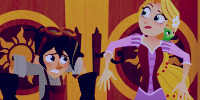
character design is a deliberate , carefully thought out process , often times with the goal in mind to show a character’s personality within the first few glances. ( ie: varian’s goggles and apron showcasing that he’s a scientist of some caliber , or cassandra’s pale , gothic features giving off the impression of the stereotypical “bad girl” )
so the parallels between varian and rapunzel?
RAPUNZEL VARIAN- golden hair - dark hair / blue streak- green eyes - blue eyes- freckles* - freckles*
* freckles are even shown to be a RARE TRAIT in corona. rapunzel writes about it in her journal here: (x.)
PERSONALITY

just like rapunzel is known for her free spirit , varian is known for his ambition &. his drive to prove himself. the two both sport bubbly , eccentric personalities , always moving quickly and fluidly , and jumping about in bouts of excitement. everything about varian and rapunzel is dramatic. they are both the type of person to GO BIG or GO HOME ; they are ALL IN or NOT AT ALL.
to that end , they are both awful liars ( “i’m brushing my teeth” - rapunzel , s1e0 / “i didn’t hear any tremors.” - varian ; s1e1 ) , and hide their negative feelings from people that they care about. ( rapunzel hiding her feelings about settling down in “before ever after” / varian hiding his feelings when cassandra reveals she chose to be a personal security detail in “great expotations”. ) both of them also tend to be clingy and expect immediate friendship out of people ( rapunzel with uncle monty in “rapunzel’s enemy” / varian with cassandra in “great expotations” ) , and are slow to anger unless pressed to their last nerve. ( rapunzel letting down her hair in “the quest for varian” / varian turning villain in his last few minutes of “the alchemist returns” )
other notes are that they both have animal companions ( pascal / ruddiger ) , both are inventive , and both are artistic.
I HAVE A DREAM
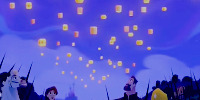
throughout the course of “tangled” , we watch as rapunzel explores and pursues her dream of wanting to see the floating lanterns. it’s been her lifelong dream , and she has to FIGHT &. go against the confines of her bubble &. the wishes of her “mother” in order to see it through.
likewise , in TTS we see that now , rapunzel’s dream is to travel the world. she wants to see what life has to offer now that she has the freedom to actually go out and see it , and YET AGAIN she has to fight for her freedom and her ability to roam as she pleases.

varian , on the other hand , dreams of becoming a well-renowned ALCHEMIST. he wants to prove to the world that his inventions and experiments are valid , trustworthy , and safe. he yearns for the chance to prove that he is far more than what his reputation says he is. pursuing the science of alchemy is his lifelong dream , and he has to constantly fight &. go against the confines of his society ( corona , his village ) in order to see it through.
UPBRINGING
this one has to be split up into TWO PARTS , because there is a LOT to go off of here. so let’s start with:
RAPUNZEL &. VARIAN VS. THE WORLD
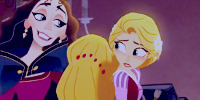
i’ve briefly mentioned it here: (x.) but varian and rapunzel both have mirrored upbringings. while true , varian was not at ALL raised in an abusive household ( FAR from it , mind! ) , there are enough similarities between the two characters that ought to be mentioned.
in “tangled” , rapunzel experiences a multitude of things , but namely:
rapunzel was isolated in a tower for 18 years of her life
gothel implies that she’s a liability &. takes up A LOT of gothel’s time ( complaining to rapunzel about the shell paints a few days before rapunzel’s birthday )
gothel tells her that the world is full of scary , dangerous people ( ruffians , thugs , men with pointy teeth )
gothel tells her that people will only want to use rapunzel for her hair , and once she HAS been used for her hair’s healing properties , they’ll toss her aside and she’ll be left alone.
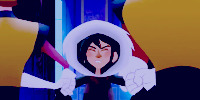
varian has a take on life that is almost the complete inverse of rapunzel. that being in the sense that everything false that gothel tells , or puts rapunzel through is actually TRUE to some respect in varian’s walk of life.
varian is always shown on his own on-screen , with minimal interaction with friends or his father most of the time. he also ends up isolated for a period of time after “queen for a day".
he’s shown to barter for people’s time ( “if you come , i’ll show you something special” - s1e1 , “it’ll only take 5 minutes” - s1e8 ) , which implies that he’s not used to people spending time with him of their own accord. this likely being with people outside of his family circle of 1
his reputation in corona is utterly tanked before we have a chance to meet him. people consider him a “dangerous wizard” as explained by cassandra in “what the hair?!” , and he is later vilified with the rumour that he attacked the princess during the events of the blizzard. he IS the danger , even when we see that his intentions in the beginning were always pure , and came from a place of wanting to help others.
regardless of the main trio’s ( or writer’s ) intent , varian is often times used for his inventions , intelligence , and/or willingness to help. sometimes all three at once. in fact , each and every one of the main cast use and scrap varian with little aside for his feelings.
eugene was only interested in being around varian once he realized that varian could tell him a secret, something he wanted in order to spite cassandra. it’s actually the ONE TIME eugene is nice to varian , and even then he is impatient and short with him. ( s1e1, “what the hair” )
cassandra brokered a deal with varian in order to get all of her lady-in-waiting chores done. needless to say , not only did she NOT hold up her end of the deal , but she actively chose not to honor it EVEN WITH rapunzel’s prompting. ( s1e8 “great expotations” )
rapunzel automatically assumes that varian will want to help her uncover the mystery of the rocks at the end of “great expotations” , explaining to him that it is a SECRET and that he can’t speak to anybody about it. she never asks him if he wants to join her in keeping her secret, regardless of whether he agrees or not. later this backfires on them both , as neither one of them can openly speak about the rocks during the blizzard , and varian is left to deal with the loss of his father alone. she also never goes to find varian until he reaches out to HER to find his bronze graphtyc. ( s1e16, “queen for a day” , s1e19 “the quest for varian” )
PARENTS ( FRED &. QUIRIN. )
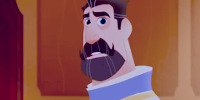
even besides the iconic “you are not ready” quote , even FREDRICK and QUIRIN have parallels* to one another in terms of parenting.
both parents are overprotective of their only child due to past experiences tied to the rocks. ( the sun drop flower / the destruction of the dark kingdom ) they both lie , and hide their motives from their child ( fred hiding the truth about plucking the flower / quirin hiding his mark ) , even knowing that rapunzel and varian respectively are looking for answers.

likewise they both try to contain the threat ( fred hiding the markers for the rocks on the map / quirin moving the village away from the rocks once he has obtained new land ) &. keep their child away from said threat ( “i don’t want you near those rocks” - fred / “stay away from those rocks” - quirin ) , never realizing that both children have already started to dabble in it anyways.
*the two parents also have parallels when it comes to the family portraits , which you can find my analysis on here: (X.) this ties in to the bigger theory that quirin and varian are direct parallels to the royal family and kingdom of corona. you can find that &. its evidence here (X.)
INVERSES
my last point has to do with all of the above accumulated.

rapunzel is constantly praised &. rewarded for her free spirit , even to her own detriment. she is always able to lift others up without fail. she is constantly shown to be the one who helps bring light into the worlds of those who have lost their way. she is the one to put a smile onto faces who never thought they could smile again , and she’s helped multiple people find &. pursue their dreams. in the case of eugene she has even given some people a reason to find a new dream.
even when her methods &. exuberant personality can grate on the nerves of others , or push boundaries that oughtn’t be pushed , 9/10 times , rapunzel still gets some kind of reward for it. the only time she’s been called out on her free spirit resulting in selfishness is by cassandra in the recent episode “freebird”.

varian , on the other hand , is often punished for his pursuit of alchemy. sometimes not explicitly , but rather in the fact that they oftentimes go completely wrong. although his intentions and aspirations are usually innocent &. well-meaning , he tends to get the short end of the stick anyways. either people assume he’s bad news because of his “dangerous” reputation , or his inventions cause a calamity that he has to clean up. in the end it’s this stigma against varian , and being ostracized for it that drives varian over the edge. ( and then only after a long period of isolation and grieving over the loss of his sole parent. )
of course that isn’t to say that varian is entirely scott-free. just as rapunzel’s free spirit can result in selfishness , an “all-about-me” attitude , and some vein of self-righteousness , varian’s hubris in his mastery of alchemy , &. overeagerness to prove his reputation wrong can and DID result in pride , a tendency to over-attach , and a knack for denial when it comes to admitting when he’s wrong.
CONCLUSION
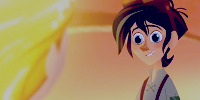
all of that to say: rapunzel and varian have a LOT of similarities. from physical appearance to personality to their experiences with the world , and the world’s experiences with them. ( chris even confirmed this here (x.) )
the varian at the end of season one is what rapunzel could have been had she become jaded and isolated in mother gothel’s care at the end of “tangled”. the irony in that? rapunzel and her friends are all equally small parts of what prompted varian to become a villain in the first place.
#☄ ———— you’d be surprised what people will tell you for a cookie. / anon.#☄ ———— the alchemist logs. / answered.#☄ ———— the common word may even be the best one. / ooc answers.#☄ ———— rumour has it it's a shoe-in for the first prize in the contest. / meta.#☄ ———— i started the rumour. / my meta.#i'll split this into parts for those who don't want to read nearly 2k words#seriously the analysis itself is 1999 words#i'm so mad it's not 2k
101 notes
·
View notes
Text
Review for 2.13: Those of Demon Blood
Let me start this review by saying this is in my honest opinion the best episode Shadowhunters has presented us so far. It has the strongest narrative and it has the best distribution of screen time between the main seven characters and the supporting cast. The episode is all about racial discrimination and it does not shy away from talking about real world issues like police brutality, anti-semitism, and corruption. This is the kind of quality content I want from my teen fantasy show.
We get back to the Inquisitor’s promise of showing Jace what it means to be a Herondale as she makes him Head of the Institute, despite Jace himself appointing Alec as the best suited for the position. There is not much time for discussion, however, when shadowhunters are being killed by downworlders and having their runes taken away. The first victim was attacked by a werewolf, which prompts the Inquisitor into calling Luke in for questioning.
Meanwhile, Max Lightwood makes a comeback now that he has graduated Shadowhunter School and Izzy is the one in charge of training him. Lightwood siblings scenes are always a highlight of the show and the exchanges between Izzy and Max are no exception. Unfortunately for Max, though, Izzy tells him to stay at the Institute as she investigates the murders.
Upon being flat out accused, Luke suggests a DNA test to prove his innocence and is unsurprisingly cleared of all charges. The shadowhunters, then, decide to go to their downworlder friends and ask them for DNA samples with the intent of clearing them from the murders. This decision sets up three different dynamics: Alec and Magnus; Clary and Simon; and later on, Izzy and Raphael.
Alec and Magnus: Alec goes to Magnus’ loft, just to find Magnus wearing his most daring look yet. He claims the extravagance comes from boredom and is especially affectionate towards Alec, which raises some red flags after the last events. Magnus assures Alec he is fine and thus starts a masterfully acted scene where Alec asks for Magnus’ hair. If it is uncomfortable for Alec to ask, it is even more so for the viewer to see to see how rightfully angry Magnus gets, claiming he wasn’t aware there was anything he had to be cleared of. Magnus asks Alec why he was back to following orders instead of his gut, to which Alec responds that all he is asking is for a strand of hair and not something dramatic. Magnus ultimately complies, but then tells Alec to get out of the apartment. Both of them are visibly upset.
Clary and Simon: Clary explains to Simon that the DNA sample was Luke’s idea as Simon seems reluctant. The vampire then tells Clary about his grandmother Helen, who was the sole survivor of his family after the nazis invaded Polony. Simon draws a comparison between what Clary is asking and what it was inflicted on the Jews and says this is why he refuses to comply. Clary, who had no idea, apologizes and seems to reconsider the entire situation. When she is on her way back to the Institute, Clary is attacked by whoever is killing the shadowhunters but Simon saves her.
At this point, the Clave is pulling out the big guns. Inquisitor Herondale informs Jace he is to put a tracking device on all downworlders, saying that, just like shadowhunter can be tracked by their runes, so should the downworlder’s whereabouts be known at all times. The scene is played in the classic angel and devil on Jace’s shoulders, with Alec being immediately and vocally against the order and highlighting how wrong it is. He is following Magnus’ advice to trust his gut and he firmly draws the line there. The Inquisitor, however, wins when Jace decides to go with her plan. He is visibly torn between what he thinks is right and pleasing his new found family. As Maia explains in a later scene, that is making him lose his way.
Jace then goes back to the Hunter’s Moon and tells Maia about the GPS implants. She is not amused, especially when Jace reproduces the Inquisitor’s justification. The confrontation quickly escalates to a fight, in which Maia ends up with a chip at the back of her neck. Luke stops the fights and tells Jace that his actions will only start a war between the shadowhunters and the downworlders.
Both Simon and Maia end up arrested, the first for refusing to leave while Clary recovered from being attacked and the second for being accused of killing a shadowhunter after being found walking near his place of death. Clary confronts Jace on his passiveness and she is not having his lame excuse of “there are no easy choices”. She also does not stand for Maia’s arrest and we are graced with yet another iconic line from Maia: “I’ve been stopped by cops for no other reason than being black, but I thought the shadowhunters were more evolved than that.”
It is only after the Inquisitor is gone that Jace starts to listen to reason. He and Clary release Maia and Simon, and Jace uses his Herondale privileges to give his position to Alec. As the official Head of the Institute, Alec’s first order is to cease the chipping of downworlders immediately.
As we reach the last third of the episode, the last of the three shadowhunter-downworlder dynamic previously mentioned takes place:
Izzy and Raphael: Izzy meets with Raphael outside of the Hotel DuMort and starts out by assuring him neither her nor Simon would ever hurt Rosa. Raphael has no time for apologies (which is the very first he ever got in the show, not that anyone is counting) and cuts to the chase: his clan is not following the Clave’s discriminatory policies. Izzy immediately agrees and asks for his help to find the murderer. Raphael says it is not a vampire and tells Izzy about a time before the Accords when shadowhunters would hunt down downworlders and keep their body parts as trophies after killing them. He also tells Izzy there was a Seelie Knight that wanted to do the same to shadowhunters a few decades ago. Meliorn.
They join forces and go after Meliorn, only to find out Max has been following them. Izzy tells Max to hide and when Raphael and she find another body and Meliorn, they are ready to attack. Meliorn tells them he is not the killer and Izzy believes him (“Seelies can’t lie and I believe you”). The three go back for Max, but he is gone, taken by the killer.
We find Max being dragged through the killer lair and find out it was Kaelie who has been behind the murders, as a retribution for losing her brother on the night of Valentine’s massacre. It is somewhat an underwhelming revelation because, you know, in the immortal words of Jake Peralta (Brooklyn Nine-Nine): “Cool motive, still murder.” Raphael and Meliorn fight Kaelie and Izzy kills her, but there is some indication that there is more to this story than meets the eyes when the Lightwood trio discusses Kaelie’s methods.
Aside from the main plotline, we got to see individual character arcs developing. After Alec’s visit, Magnus calls Dot and they discuss the new shadowhunter policy and warlock love over some drinks. We find out that not only Magnus and Dot have known each other for quite some time, they were together for a while at some point (more importantly, we find out Magnus is just like everyone else and had a crush on Freddie Mercury). It has been some time since we last saw Magnus with a friend of his own and it is great to be privy to his personal life outside of the shadowhunter extravaganza. The warlocks also perform a lively and literally magical dancing number (choreographed by Harry Shum Jr.) that ends up with Dot making a move and Magnus refusing her, saying he is in love with Alec and that he “has always been a one soul at a time kind of guy”.
One minute of silence for the cheating biphobic stereotype murdered by this scene. You won’t be missed.
Simon is still struggling with being a Daylighter and he finds himself in an even more complicated situation: vampires from Raphael’s clan want to follow him. Apparently, there has been prophesied that a great leader would show up and they think Simon is the guy. He refuses them, preferring to focus on his somewhat normal life as a music major in a relationship. At the end of the episode, Simon performs a sweet number with the support of Clary to a full house and the scene sets a hopeful tone to an otherwise heavy episode.
Lastly, Jace and Maia, who had a rocky start and have since been developing a snarky kind of friendship, share a few charming scenes throughout the episode. With the exception of the scene where Jace comes into her bar to chip every downworlder present, that is. Aside from that little number, we see their increasing chemistry spiral up when they presumably hook up at the very last scene of the episode, after Jace takes the chip off of Maia’s neck. It means nothing, according to Maia, but that is the second WOC in charge of her own sexuality on my screen under forty minutes, so it certainly means the world.
Personal Notes
Luke and Simon’s talk was awkward to witness and not in a fun way. There is a little hint there about Simon possibly losing control over his bloodlust while being intimate with Clary, so I hope that pays off. I usually love their interactions but something about this one didn’t quite sell it for me.
I may not like the Inquisitor but her scene talking about the Herondales was very touching. It is nice to get to know more about Jace’s real parents and see him learning about his heritage under a positive light for a change.
Alec pointing out that the Clave wouldn’t give him the position of Head was the perfect way to showcase how the Clave’s bigotry doesn’t only affect downworlders in a vacuum: Alec is in a m|m relationship with a downworlder, which makes him twice as undeserving. It is not only a matter of homophobia, it is also racism playing in the mix.
Clary: “So the Herondales are what? Like the Kennedys of the Shadow World?” Alec: “They are an old shadowhunter family, like the Lightwoods.” Izzy: “But we are the Kennedys.” Izzy, please never change.
“I’m not alone, I’m here with you. The High Warlock of Brooklyn.”
18 notes
·
View notes
Text
MTVS Epic Rewatch #163
BTVS 6x12 Doublemeat Palace
1) I think we can all agree that Doublemeat Palace is not going to go down in television history as one of the most iconic episodes of the century. But you know what? It’s not that bad. Or, at least, it’s not worse than other bad Buffy episodes, you know? There are some funny moments here and there, some big stuff for Willow’s season arc, and it gave us the opportunity to get all those lame dick jokes out of our system.
So, to celebrate the badness that is Doublemeat Palace, send me your favorite dick jokes that remind you of this episode. You know, just keep it classy. Or not?
2) Willow was practically drooling as she described all the magic stuff they’d found at the Trio’s lair, which makes me wonder whether some of the stuff Amy told her at the end of the episode was really that farfetched or she was actually quite on point.
3) And after, what, three seasons? we finally get an answer as regards Anya’s source of income...
ANYA: When I was a vengeance demon, I caused pain and mayhem, certainly. But I put in a full day's work doing it, and I got compensated appropriately.
4) Cutest Buffy ever!

5) If there is one thing this episode does right is recreating the oppressive and gloomy atmosphere that pervades dead-end jobs in the service industry.
6) This is such a small moment but I kinda love it. The scoobies show up at Buffy’s work to show some support, and Buffy’s like...
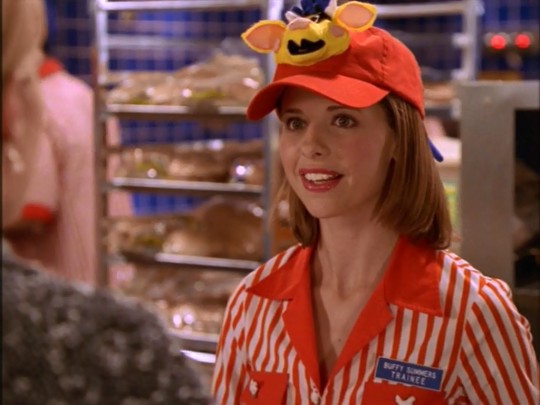
...genuinely happy and smiling for the first time in a long time?
7) You’re a pig, Spike.
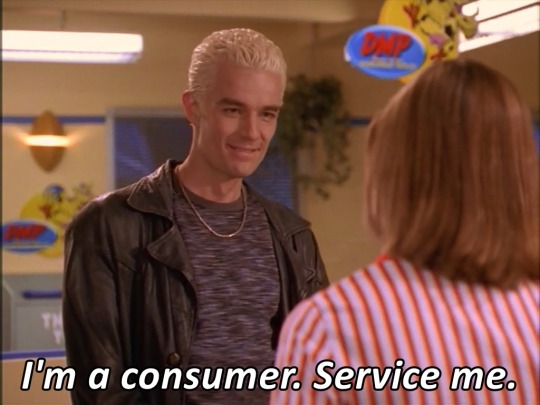
8) And then...
SPIKE: You're not happy here.
BUFFY: Please don't make this harder.
SPIKE: You don't belong here. You're something... you're better than this.
BUFFY: I need the money.
SPIKE: I can get money. Walk with me now, come on.
BUFFY: I... I need to go help Gary with the fries.
The way she quietly asks him to not make it harder on her is rather heartbreaking. She’s not telling him to fuck off, as she would normally do. In a way, she’s admitting that he kind of gets her, very much in spite of herself. He’s right: she’s not happy, and she doesn’t belong there. And you can tell that she needs to busy herself when he offers her an out because she’s actually considering it.
9) You know what? I think Halfrek became a vengeance demon so that she could the dramatic entrance thing on a daily basis. I mean...
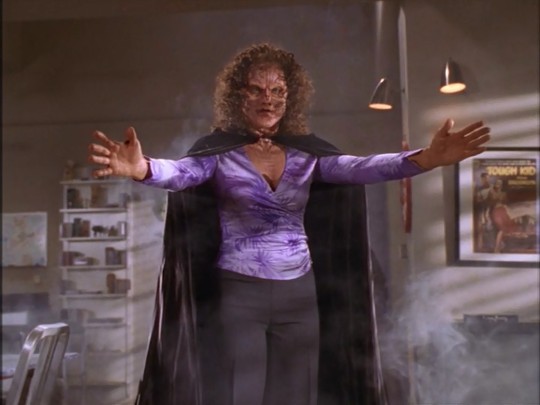
10) OMG I’M HALFREK!
HALFREK: So, um ... you're marrying that man with the large upper arms?
ANYA: Yes.
HALFREK: Why?
ANYA: Well, because I love him.
HALFREK: Hmm.
ANYA: Oh, we're gonna be very happy together.
HALFREK: Hmm.
ANYA: What?
11) Do you get the feeling Buffy was embarrassed to have Spike see her in her Doublemeat Palace uniform in this scene? Just the way she quickly removes her hat once she sees him...

12) This is not the most scintillating love-making to have ever graced our screens...

(I do love the “teamwork” poster next to them, quite appropriate...)
13) Okay, this is really sad?
WILLOW: D'you want something?
AMY: Um... yeah... actually. I mean, I don't know if you wanted to keep it, or...
WILLOW: You want it? Really?
AMY: Well, yeah, you know, I mean... it's not much, but it's home. Or it was. I don't know, I guess it's stupid, but...

She calls it HOME.
14) I’m so ashamed, this is literally how I highlighted texts back in college. My friends used to make fun of me because of it.

15) It’s really difficult for me to read Amy and her intentions. On the one hand, she actively seeks Willow’s company. On the other hand, she holds a grudge against her because in her eyes Willow didn’t try hard enough to break the spell that turned her into a rat. At moments, it seems like she’s truly lonely and is desperately seeking for a friend. Then, it kind of feels like she’s only trying to mess with Willow’s mind? I guess it’s possible that she was doing both.

AMY: So this is it, huh? This is... gonna be your life from now on?
WILLOW: What? No.
AMY: Well, you're never gonna do it again. Ever. You're never gonna... feel how it made you feel.
WILLOW: Don't think that's the way to look at it.
AMY: Hey Will? It's your birthday.
WILLOW: Um, no it isn't. But now that you mention it, Buffy is coming...
AMY: Potestas.
WILLOW: What? Amy...
AMY: It's a gift. It's magic... and it didn't come from you. It came from me. Completely legal. Enjoy.
I think she might have also felt like, by giving up magic, Willow was trying to show she was better than Amy, that she was above the whole thing. And Amy kind of wanted to drag her down to the mud with her.
16) One of my favorite Buffy scenes, tbh.


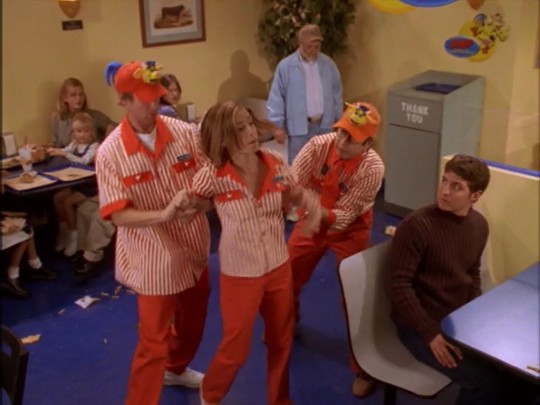
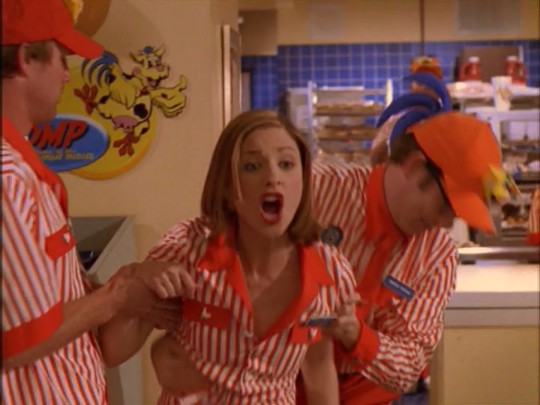
(they shouldn’t have been able to hold her back, though)
17) This was funny!
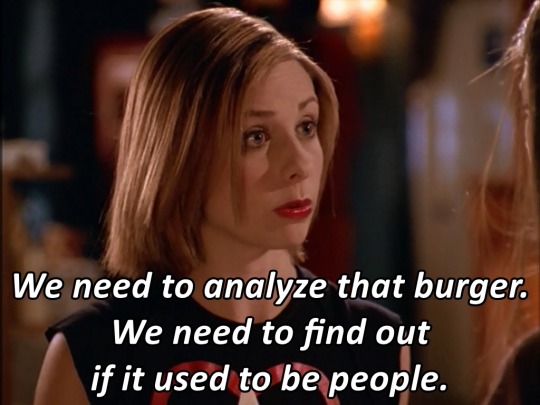
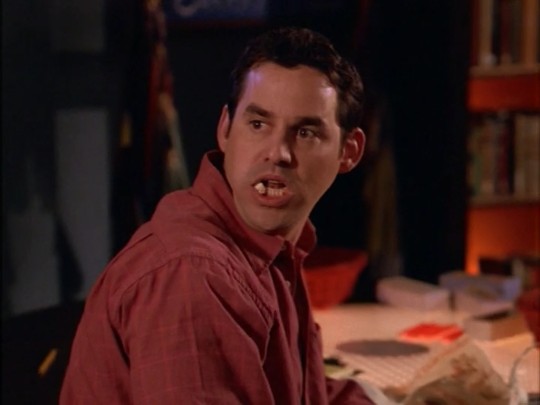
18) I do love how hard Willow was trying to fight off the urge to use the magic Amy had given her and to shake it off of her system. It truly took a lot of force of will (unintended pun.) Considering she later came clean to Buffy about the whole thing, I wonder if it wouldn’t have been better if she had told them about it while she was going through it. Of course, I guess she feared they might judge her or blame her for it. (Or, maybe, she wasn’t sure she’d be able to pull through and she didn’t want them to witness it...)
19) Again with the sadness...
DAWN: Buffy's never gonna be a lawyer, or a doctor. Anything big.
XANDER: She's a Slayer. She saves the whole world. That's way bigger.
DAWN: But that means she's gonna have like crap jobs her entire life, right? Minimum wage stuff. I mean, I could still grow up to be anything. But for her ... this is it.
XANDER: Okay, but maybe you'll be a lawyer or a doctor, and you can use all your money to support your deadbeat sister.
DAWN: Oh, that's terrifically better. Thanks.
1) This shows a lot of growth for Dawn. Just one season ago, she was the annoying little sister who believed her big sis was leading a glamorous life because she was a superhero who in her eyes could get away with anything. She’s older now, and she understands that killing demons, kicking butt and saving the world is not all that’s been cracked up to be. There’s a very sad side to being The Only Girl in All the World Who, and Dawn is finally able to actually get that. Also, imagine how many times poor Buffy has probably considered the same gloomy future... 2) Xander actually said what I was thinking. Buffy may not be able to get that Normal Future, but Dawn could, and she could definitely help lighten Buffy’s burden on some fronts (plus, all Buffy ever wanted was for Dawn to have a future, so she’d be giving her big sister exactly what she wanted.)
20) In the end, Halfrek got in Anya’s head, which basically means neither Xander nor Anya were ready to get married.
21) Ugh this old lady was such a dickhead...

(I know that joke has probably been made a thousand times, but I’m not gonna waste my good jokes on this crappy episode, right? Also, I couldn’t come up with anything better.)
22) Willow doesn’t really know if Buffy is listening, but she needs to get this off her chest anyway. Also, I really love that Buffy is the one she keeps turning to during all her hard times in season 6. I just kind of wish Buffy had done the same, you know?
WILLOW: Buffy, there's more. Something happened today... i-it wasn't my fault. It was Amy's fault, but I feel so bad about it. It was Amy's power, but, but it felt like I was doing everything myself. And I couldn't stop. And now it's gone and I feel kinda shaky and... like I, I need it ... Buffy?
I think it was important for her to admit that she felt like she needed magic and that she was struggling not to use it. It’s all part of the journey of giving something up, right?
23) I find a lot of beauty in the fact that it’s the lesbian the one who chops off the dick...


...and the one who is most scared of it, too...

24) Buffy asking for her job back at the end of the episode breaks my heart :(

#Buffy the Vampire Slayer#BTVS#Buffy Summers#Joss Whedon#Willow Rosenberg#MTVSepicrewatch#BTVSrewatch2015#Doublemeat Palace#mine#recap#btvsrecap
49 notes
·
View notes